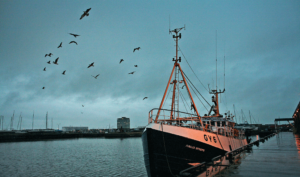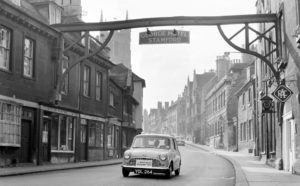There are certain English villages, wrote Bill Bryson, “whose very names summon forth an image of lazy summer afternoons”. One example was Theddlethorpe All Saints. Lying on the quiet Lincolnshire coast north of Skegness, Theddlethorpe’s approximately 500 residents are served by a thatched pub and two handsome medieval churches, which stand out against huge skies. Yet storm-clouds are building on the horizon; soon, this obscure corner of England could be the backdrop to a dystopian tale.
Theddlethorpe has always had an industrious underbelly. Between 1972 and 2018, it was known for the Theddlethorpe Gas Terminal, where natural gas gathered from beneath the North Sea was collected, then fed into the National Grid. At its peak, Theddlethorpe handled around 5% of the UK’s gas supply, but with the shift away from fossil fuels, the plant became redundant. In 2021, just as locals were feeling grateful for the site’s long-promised return to agricultural use, came news that the terminal might have an unwelcome afterlife — as the landward end of an undersea nuclear waste dump.
It is one of four sites being considered by the government for a Geological Disposal Facility (GDF), the others all being on the far side of the country, near Sellafield, a huge nuclear site in Cumbria. The idea is that vast storage caverns would be blasted into bedrock up to 1,000 metres under the sea, several miles offshore. “Higher activity” radioactive waste would then be transported to Theddlethorpe from 23 surface storage locations across the UK, and trundled out along a tunnel, to be walled up and forgotten.
The news was as unexpected as it was unpleasant. The nearest nuclear power station to Theddlethorpe is in Suffolk, 96 miles away as the fallout flies, 145 miles along often poor roads. The nearest train stations to which waste could be brought are Grimsby or Skegness, each about 20 miles away and both at the end of lines in need of upgrading. Economically, the area is dependent on tourism and agriculture, both of which could clearly be affected adversely by real or even imagined proximity to vast amounts of toxic substance. And the Lincolnshire coast is incidentally famous for its large numbers of migratory birds, who could carry toxins hundreds of miles.
So, the prospect of the area becoming not just a major industrial locus, but one dedicated solely to the handling of waste with a hazardous half-life of up to 100,000 years, filled locals with puzzlement as well as dread. “Why here?” one teacher asked wonderingly. “What possible economic, logistical or political justification could there be for such a scheme in a place like this?”
The Theddlethorpe site lies above potentially exploitable energy reserves of gas and oil, and below them, coal; such geology is supposed to preclude the presence of a GDF. Nuclear Waste Services (NWS) recognises this as a problem: “Possible exploration in the future in this area means that it is more likely that future generations may disturb a facility.” As local resident and geologist-ecologist Biff Vernon points out: “Of course, we don’t want to extract these resources now, but thousands of years in the future, a civilisation might think differently. In their own literature, the GDF people rule out a site that overlies potential economic resources.”
And surely it makes sense to localise the inevitable risks of a subsea GDF. There hasn’t been an accident at Sellafield since the fire of 1957, but the beaches nearby nevertheless need to be combed constantly for radioactive objects, with 98 recovered during 2021. The immediate vicinity of Sellafield is already unfit for many other purposes; why contaminate hitherto unaffected areas? Especially because it would clearly be much cheaper to store waste close to its sources. NWS admits: “The transport provisions to the Theddlethorpe GDF Search Area are currently limited” and “significant works” would be required. The Government proposal suggests these works would cost between £20 and £53 billion — although as the tale of HS2 shows, the cost of extending transport networks is liable to gross underestimation. This throws up a question considered taboo in the discourse around large infrastructure projects: would expansion of either railways or roads really “benefit” an area whose residents generally value its rural character?
Consider the human cost of the GDF construction, which would go on for many years prior to the arrival of waste — years of 24/7 disruption, heavy traffic, noise and huge spoil heaps. Much of this work would need to be carried out by brought-in specialists operating on short-term contracts. Any real jobs that may ensue would probably not materialise for at least a decade. As local Labour leader Tony Howard told BBC Radio Lincolnshire in 2021: “You’re not going to convert people from serving ice cream into nuclear waste specialists overnight.” Nevertheless, the NWS is promising thousands of new jobs for an area plagued by high seasonal unemployment. Older locals remember similar promises of skilled jobs being made when the gas terminal was first proposed. They were never kept.
Few in Lincolnshire feel compelled to martyr themselves for the sake of national sustainability. Investing in nuclear energy is part of the Government’s 10-point plan to achieve Net Zero by 2050, but according to new UnHerd polling, Lincolnshire is apathetic towards this ambition. In Louth and Horncastle, the constituency that Theddlethorpe sits in, 30% of respondents agreed that the Government spends too much time on green issues (and a further 28% didn’t know). No wonder, given that a Government proposal threatens to destroy their environment rather than protect it. This scheme is in many ways just another example of the clumsiness of too many “levelling up” projects — a top-down, bean-counting, crassly reductionist exercise in national political management, in which local character, local feeling and even local realities are largely side-lined.
And in the meantime, uncertainty reigns. There is no deadline yet for the final decision, although the sites are supposed to be narrowed down to two in 2026. In an already economically depressed area, local businesses are in limbo, and growth has been stunted. What tourism-related enterprise would invest in a coastline where the number of visitors might abruptly and markedly decline? What food processor or retailer would actively seek out produce from anywhere near a nuclear facility? How can councils plan long-term strategies? What about residents who wish to improve or sell their houses? It is too easy to dismiss local objections as selfish NIMBYism, but some of today’s protestors will not even be around if or when construction starts. They are doing it for others, and for posterity.
NWS is clearly aware that its plan possesses few obvious attractions. It states that nothing will be built unless there is community backing, formalised by a “Test of Public Support” — a poll or referendum. It has accordingly set up the Theddlethorpe GDF Community Partnership to make its case (chaired by a former leader of Nottingham City Council, with a reported salary of £750 per day). So far, it has papered the area with thousands of handsomely-produced newsletters, promising that at least £1m will be distributed to local causes. Given that eastern Lincolnshire is facing permanent transformation, this doesn’t seem like much.
Where is local politics, in all of this? Some councillors have not helped themselves, by claiming to have no view on the GDF, despite joining first NWS’s Working Group and now the Community Partnership. Indeed, county and district council officers were in contact with NWS long before the scheme became public knowledge, a fact that inflames local cynicism. One understands the need for confidentiality in some council business, and that councillors may be well-intentioned, but to many voters, the optics aren’t good. Locals may have the chance to air their views during this May’s local elections, as objectors plan to ask certain candidates to clarify their views of the scheme. But as one of the respondents to the GOTEC questionnaire reflected: “I honestly don’t think our opinions matter to the powers that be.”
Some say the Theddlethorpe scheme is a gesture towards “levelling-up” this overlooked part of England: a feint to obfuscate Whitehall’s underlying commitment to expanding the Sellafield site. If so, it is Lincolnshire councillors who run the risk of being out-manoeuvred, and becoming unpopular. As elsewhere in Britain, this vast infrastructure project simply highlights the naivete of some local politicians, the weakness of local government, and London’s contempt for communities of all kinds.
For this is a tale of many towns. An alliance of experienced politicians, full-time administrators and a rich and secretive industry take on volunteer activists who are largely without funds and unversed in the arts of persuasion. A glacial decision-making process, with tedious procedures and slippery language, wears down local opposition. There are not even events against which opponents can mount demonstrations. It would be appallingly easy for Lincolnshire locals, who all have other lives to lead, to lose sight of the scheme, while behind the scenes, in dozens of dull meetings, it builds up steam and ultimately goes through by default. That would be a black day for all of Lincolnshire — and a poisonous precedent for other areas in danger of being altered forever against their will.
Disclaimer
Some of the posts we share are controversial and we do not necessarily agree with them in the whole extend. Sometimes we agree with the content or part of it but we do not agree with the narration or language. Nevertheless we find them somehow interesting, valuable and/or informative or we share them, because we strongly believe in freedom of speech, free press and journalism. We strongly encourage you to have a critical approach to all the content, do your own research and analysis to build your own opinion.
We would be glad to have your feedback.
Source: UnHerd Read the original article here: https://unherd.com/




